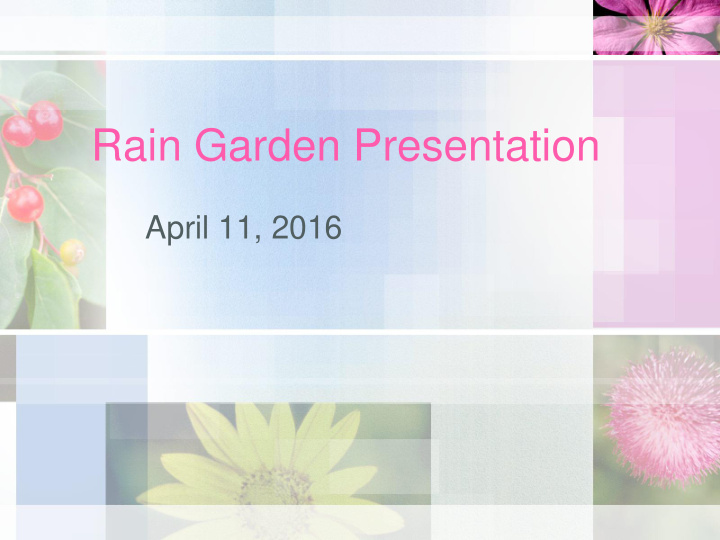



Rain Garden Presentation April 11, 2016
Mark St.Charles, Supervisor Green Oak Charter Township 2000 – present Green Oak ZBA Chairperson 1992 - 2000 MDEQ Certified Storm Water Operator since 1995 Green Oak representative for the Huron River watershed Phase II storm water permitting One of many representatives in developing the Low Impact Development Manual for the State of Michigan Life long resident of the South Lyon / Brighton Area Career in the Mining business for 43 years, manager for 40 years.
Rain Garden Facts: Rain Gardens are a best Management Practice (BMP) A BMP is One of Many Tools to achieve the goals within the Low Impact Development Manual (LID) Rain Gardens are actually “Bioretention” Islands (inverted) Rain Gardens can be as small as you want or as large as you want Rain Gardens can be simple, or complex For the first year or two, a rain garden will require more maintenance than and established one
In considering a rain garden, one must consider the desired goal. Is the goal storm water retention? Looks? Wildlife habitat? Increased property value? Hopefully its all of the above. Considerations, soil types & installation cost Soil Types. Heavy Clay or poorly draining soils, may require an under drain to control infiltration and runoff. Medium draining soils offer infiltration where water will be gone within 48 hours. Highly draining soils such as sand & gravel drain storm water within hours of a storm event. May require additional watering in periods of drought. May also require more drought tolerant plantings.
When considering including a tree or trees within your rain garden, pay particular attention to distance from your house. Distance from your septic field and driveway. Tree roots will damage your basement wall, infiltrate your septic field and get under your driveway and cause heaving of its surface. Once you have your rain garden, plan on adding to it yearly to suit your desired outcome or experiment with different spices of plant to offer variety.
Green Oak’s Considerations for a Rain Garden During rain events, our storm water limited detention pond would fill up and sometimes had several feet of water in it. Normal infiltrate times would be around 4 to 48 hours depending on the time of the year. Our goal was to treat the storm water that flowed through downspouts on the front half of the building by directing that storm water to rain gardens. We constructed two of three gardens on the front side of the Township Hall. We believe that both gardens have reduced the flow to our detention pond by approximately 40%. Our goal is to construct a third rain garden this year and achieve close to 50% of our storm water to be directed to our rain gardens.
Some things we have learned. Construct your rain garden so that it has enough time to get established before the up coming winter. We constructed ours in the fall and got hit with a very early winter. We lost quite a few plants. Our membrane was not porous enough to allow good infiltration rates. We had to poke several holes in the membrane and the one garden has worked very well from that point on. We are still experimenting with plant species. Due to our very sandy soils, the plantings on the outer edged of one of the gardens needed more drought tolerant plantings. Seeds just don’t work. Use actual plantings.
Green Oak’s Limited Detention Pond. Our detention pond is designed to detain the storm water and control the discharge to the wetland at an agriculture rate. Since the Township hall was built in 2001, we have not had one release of storm water to the wetlands. So it functions much as a retention pond. We have established wild flowers by both plantings and limited success with seeds for increased wildlife diversity.
Questions / Comments?
Recommend
More recommend